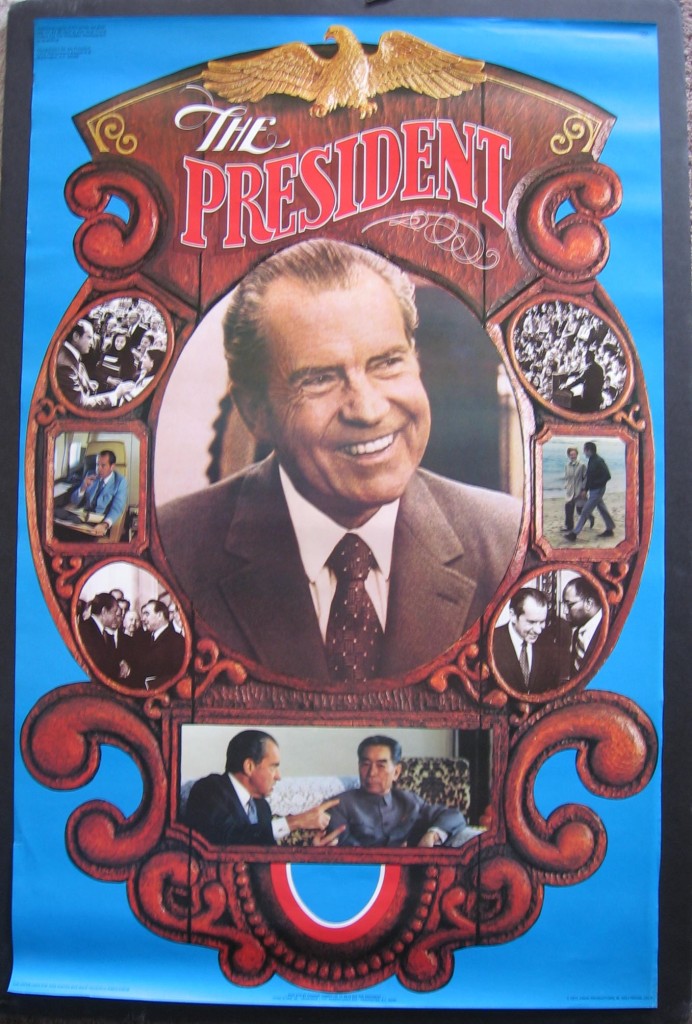
For a presidential candidate invariably caricatured as square, Richard Nixon’s 1972 re-election campaign posters were more hip than any of those before or since. “Going way out,” was a tactic to garner more of the youth vote, especially since the majority of them were polling in support of his anti-Vietnam War Democratic rival, Senator George McGovern. It could well be a graphic from the popular kid’s TV show “The Banana Splits.”
The art of politics is a deft game, played in many shades of many colors. Unlike presidential campaign posters, which inevitably uses red, white and blue.
There is an art to everything, certainly when it comes to electing a President of the United States, and the posters, banners, bumper stickers, decals and postage seals ever since the first ones appeared in the 1836 presidential campaign certainly reflect every possible configuration of the colors red, white and blue, and pattern of the stars and the stripes.
Here then is an overview of Presidential Campaign posters of nearly two centuries. Only room for the winners, alas.
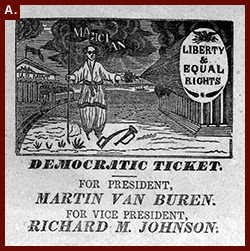
Apparently the very first presidential campaign “poster” that was mass-produced, Martin Van Buren’s 1836 black-and-white large election handbill, could be posted on any public flat surface.
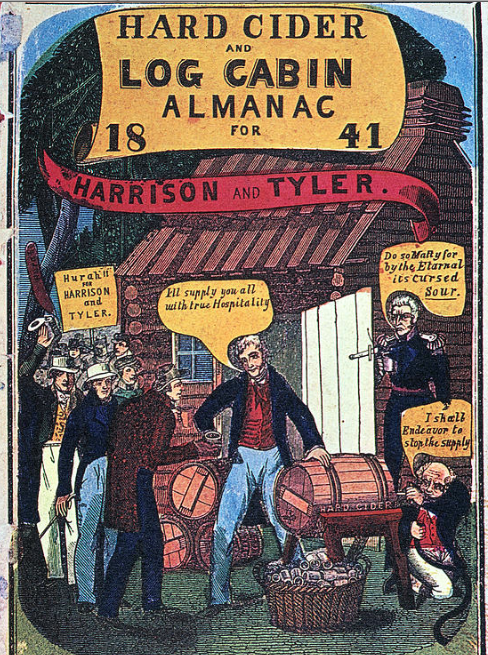
The cover of an 1840 Whig Party booklet, initially printed in black and white, was large enough to to tear and post on buildings and use like handbills. Promoting William Henry Harrison’s 1840 candidacy, it also showed his opponent, Democrat and incumbent President Van Buren, trying to drain the free hard cider passed out to those committed to the Whig candidate; behind Van Buren stands his mentor, former President Andrew Jackson.
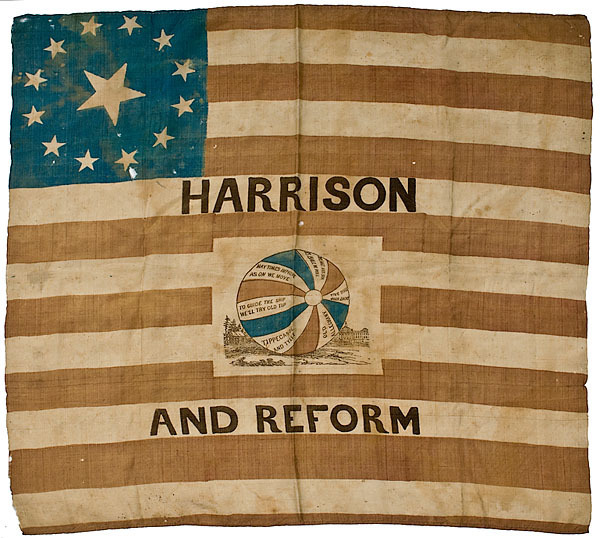
Harrisons campaign organizers would roll a large paper ball into rallies to give visual form to the expression “keep the ball rolling.” And when they couldn’t get lots of balls out there, they made flags with images of the rolling Harrison ball.
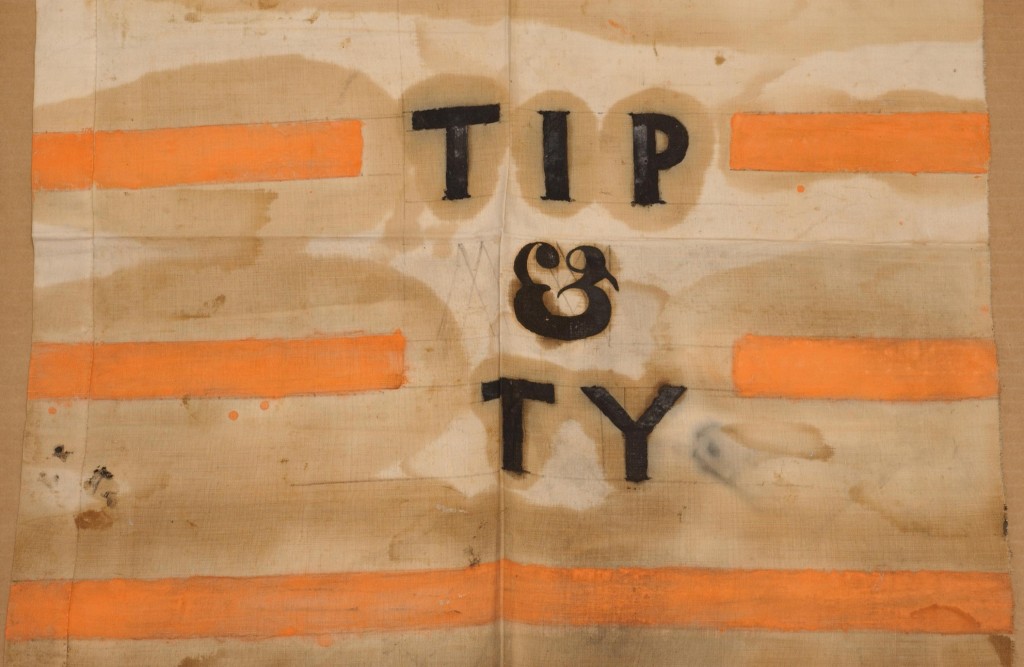
A somewhat post-modern look to this simple banner, using not red, white and blue but brown, orange and black and carrying abbreviated versions of the 1840 Whig ticket candidates’ nicknames.
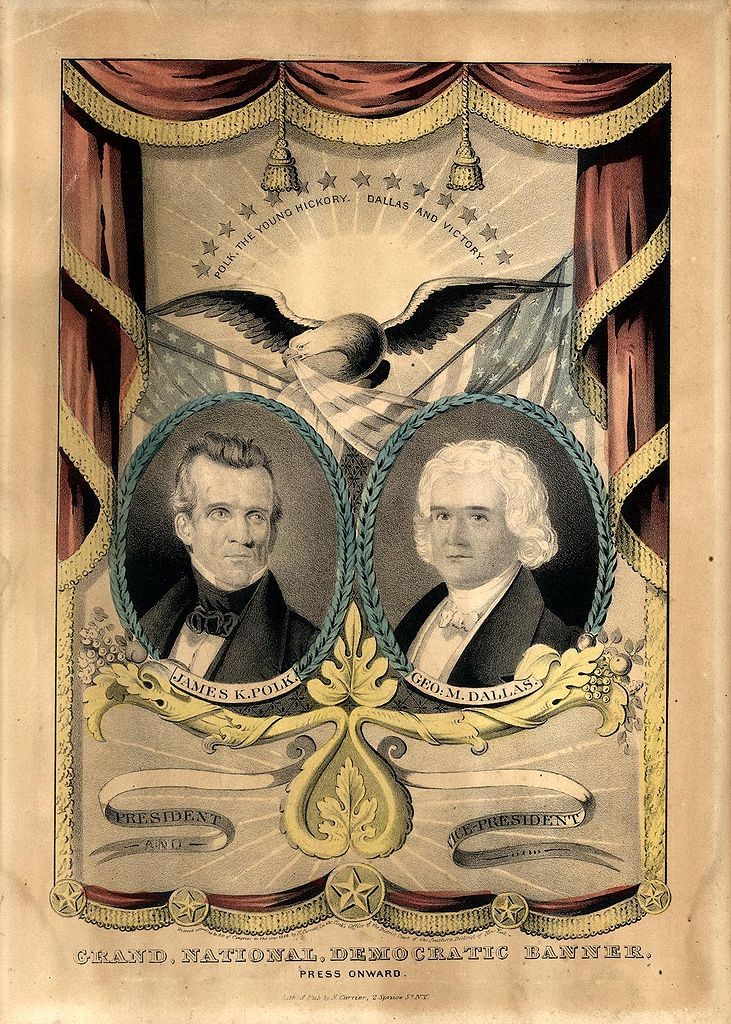
Straight-up dull like the 1844 Democratic candidate James Polk and his running mate Dallas who won that year, this banner became a prototype for many a future successful dullard elected President in the decades ahead.
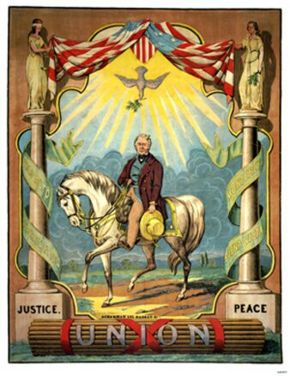
General Zachary Taylor, hero of the Mexican War, was seen as rather saintlike, with a suggestion of the Holy Trinity shining its blessing on the humble man, his celebrity horse “Old Whitey” and the broad tstraw hat that was his trademark.
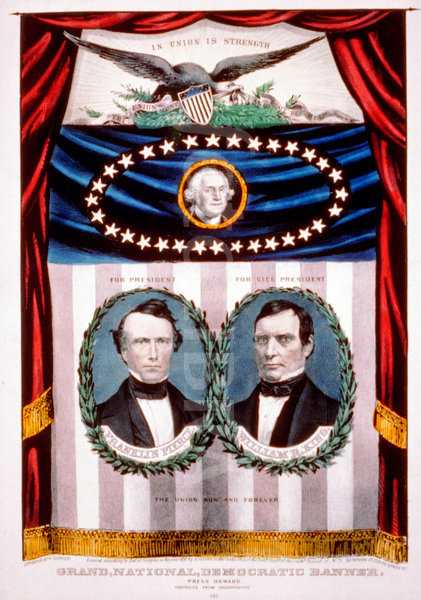
Despite the fact that he was long dead, let alone not running for anything, George Washington made an appearance above the Franklin Pierce and William Rufus Devane King 1852 presidential campaign poster, using the same boilerplate first used for fellow Democratic Polk. As it turned out, King wouldn’t live much past the Inauguration. He died shortly after being sworn in as Vice President while in – Cuba.

With curls and ribbons gussying him up, James Buchanan’s version of the same-old-same-old boilerplate poster was decidedly Victorian.

Lincoln’s 1864 re-election campaign poster carried the subtext of the Civil War ending and the nation reunited, the northern Republican paired with a southern Democrat running mate, the guns of war stilled and merchant commerce resuming.

A century and a half before Instagram, Ulysses Grant’s 1868 campaign poster told the story of his life and career in pictures.

With overconfident anticipation Rutherford Hayes was linked to all his predecessors arcing above him and his vice presidential candidate in a very wordy poster for a time when people read more.
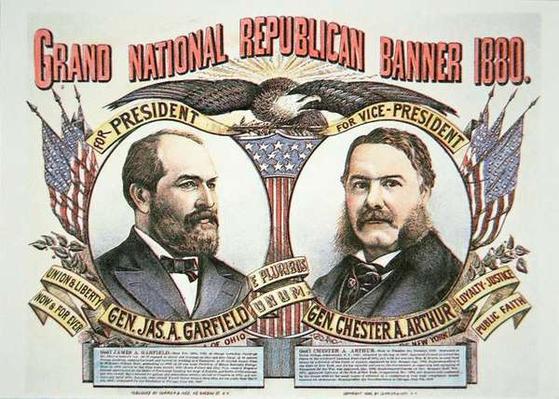
James Garfield and Chester Arthur crowded lots of platitudes like “loyalty,” “justice,” and “public faith” onto big ribbons, with their own mini-bios in barely readable small lettering.

Grover Cleveland’s 1884 campaign poster did away with all the past Republican and loser Presidents and just linked him to the big greats, George Washington, Thomas Jefferson and Andrew Jackson.
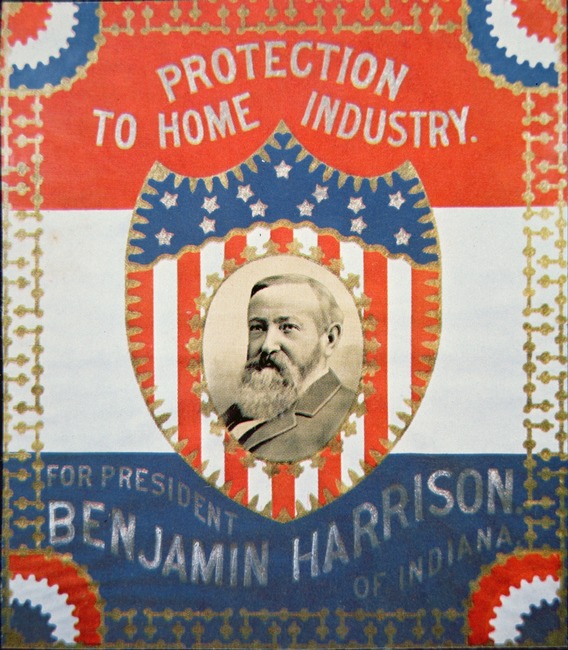
Benjamin Harrison’s campaign poster knocked off the vice presidential candidate and all the past Presidents, to focus on a jazzy, busy red-white-and-blue pattern and one simple message on the leading campaign issue of the tariff.
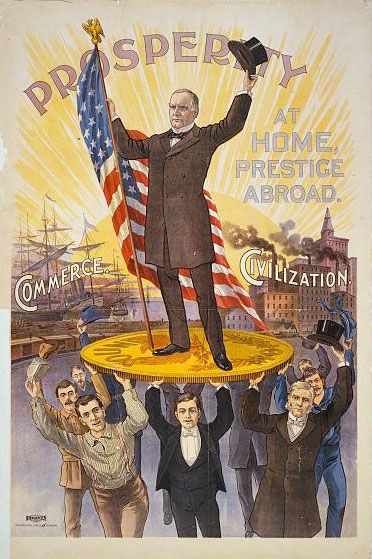
There’s lots going on in this 1896 McKinley poster. the working-class and the monied-class were shown literally supporting McKinley on a coin of the gold standard he supported, while the merchant ships and factories of booming commerce were at full steam. There’s more candidate here than the red-white-and-blue than ever before.

Theodore Roosevelt was cast in a variety of public personae, sometimes comedic, from trust-buster to Rough Rider. The Harvard aristocrat was even depicted as a farmer in shirtsleeves, sowing the seeds of prosperity, even managing to make the sun rise. The old familiar red-white-and-blue has shrunk to its smallest size ever, Teddy’s big personality seemed to be enough.
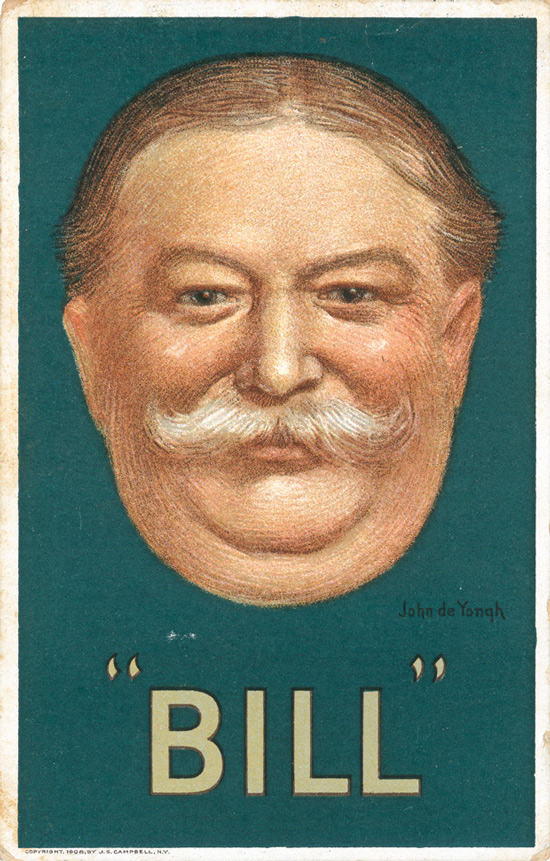
In 1908, the red-white-and-blue literally vanished for the first time in campaign poster history. If Teddy Roosevelt was figuratively larger-than-life, his successor William Howard Taft was literally so. This poster has room only for his nickname and chubby visage.

The flag returns as a campaign poster staple in 1912 for Woodrow Wilson, along with the arrogant presumptuousness that he will be as great as George Washington.

Certainly one of the more exquisitely artistic of presidential campaign posters was this 1920 one showing a slimmer-than-life Warren Harding, his hand raised in a gesture often seen on depictions of saints, while he raises Old Glory with the other hand. If the illustration evokes the dreamy illustrated art of the era, it should: legendary artist Howard Cnandler Christy painted it, famous for his White House portrait of First Lady Grace Coolidge and her white collie.

One of the most whimsical and clever uses of the red-white-and-bluie and, for the first time, no image of the candidate himself lis this 1924 postage seal. Making witty play on the name of the incumbent President, Calvin Coolidge, and on the popularity of the newfangled summertime gadget then all the rage – the electric fan, it almost suggests a manufacturer’s brand advertising.
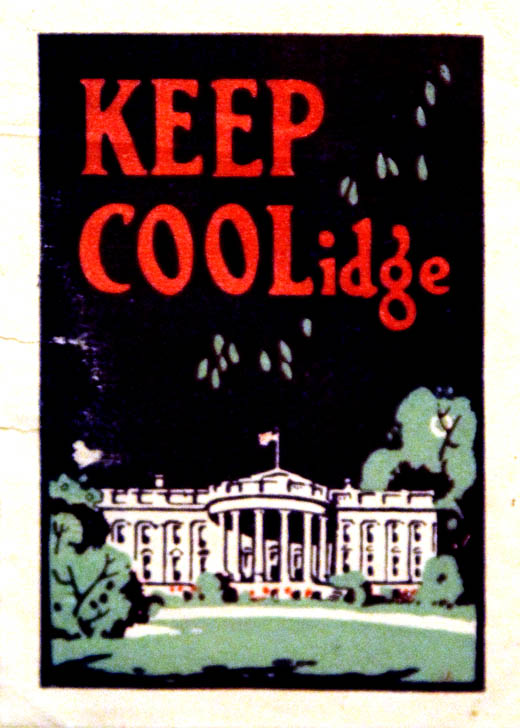
Another simple word-play Coolidge postage seal, this one without even a hint of blue – but lots of white used on the famous house by that very name.
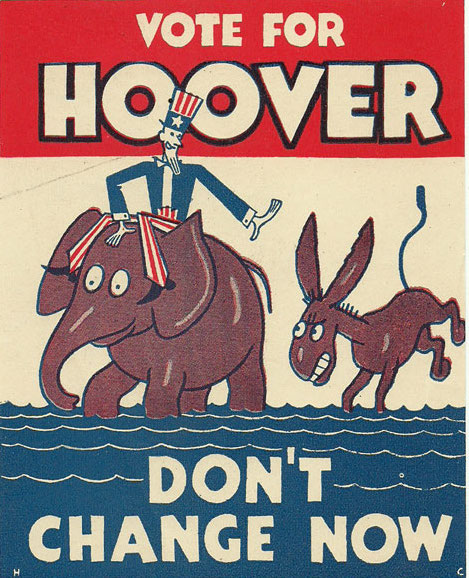
This Herbert Hoover decal continues the Coolidge tradition of not showing the personally-modest presidential candidate, but introduces not just the animal symbol of the Republcoans – but the Democrats as well, the elephant and the donkey. It also makes figural use of the blue – and brings back Uncle Sam with with his suit of stripes and a star, for the traditionalists.
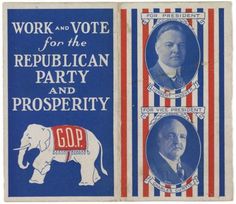
For the first time, the animal symbol of the G.OP., the elephant made his appearance in this 1928 Herbert Hoover campaign poster, alongside a unique candy-strike use of the tricolors.
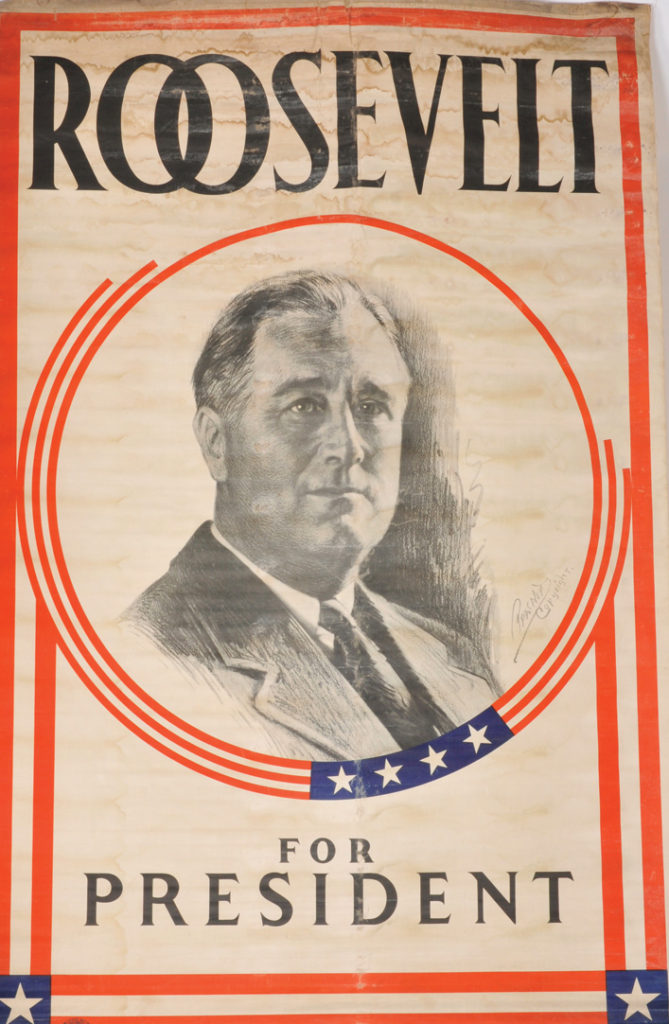
Franklin D. Roosevelt’s 1932 presidential campaign poster returned an image of the candidate within a circular set of stripes, with a tasteful smidgen of blue stars.

Roosevelt’s 1936 re-election campaign poster simply exhorted voters to keep on with him, redoing the stripes in stylish Art Deco borders.
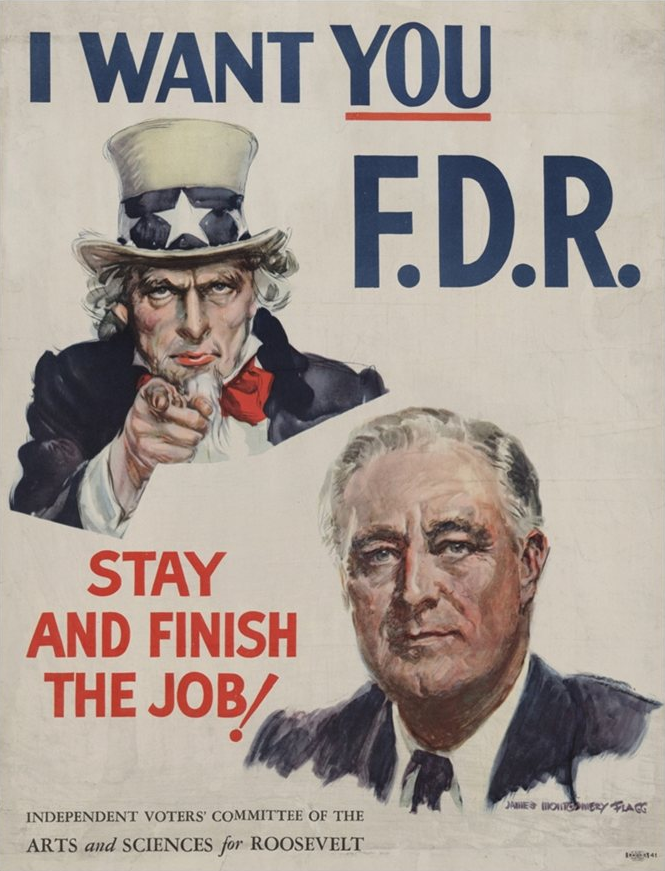
No less a figure than Uncle Sam himself came out for FDR’s 1940 campaign for an unprecedented third term in this partisan version of the legendary image of the national personification created by the same artist who conceived of the familiar U.S., James Montgomery Flagg. There’s red, there’s white and there’s blue – but not in any of the familiar patterns.

As the wearied nation sensed that the end of the war was near, FDR sought his history-shattering fourth term and in this poster is identified not by name but his iconic profile, and a sample of the diverse demographics in his alleged concerns – the American serviceman, children, farmers and salesman and, for the first time in a presidential campaign poster, the hand of an African-American.

Some of Harry Truman’s communist-accusing critics would surely read much into the red and black in this poster, and the glaring absence of any blue. Three years after World War II ended, numerous postwar global crises made for a sobering poster.

This bumper sticker used the wildly popular slogan that first pushed General Eisenhower to run as the 1952 Republican presidential candidate, adapted from the hit Broadway show “Call Me Madam” which included the song, “They Like Ike.”
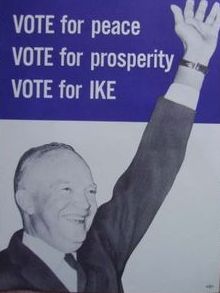
Simple-white-and-blue, Eisenhower’s 1956 re-election poster seems to presage the Kennedy and LBJ posters a generation later.
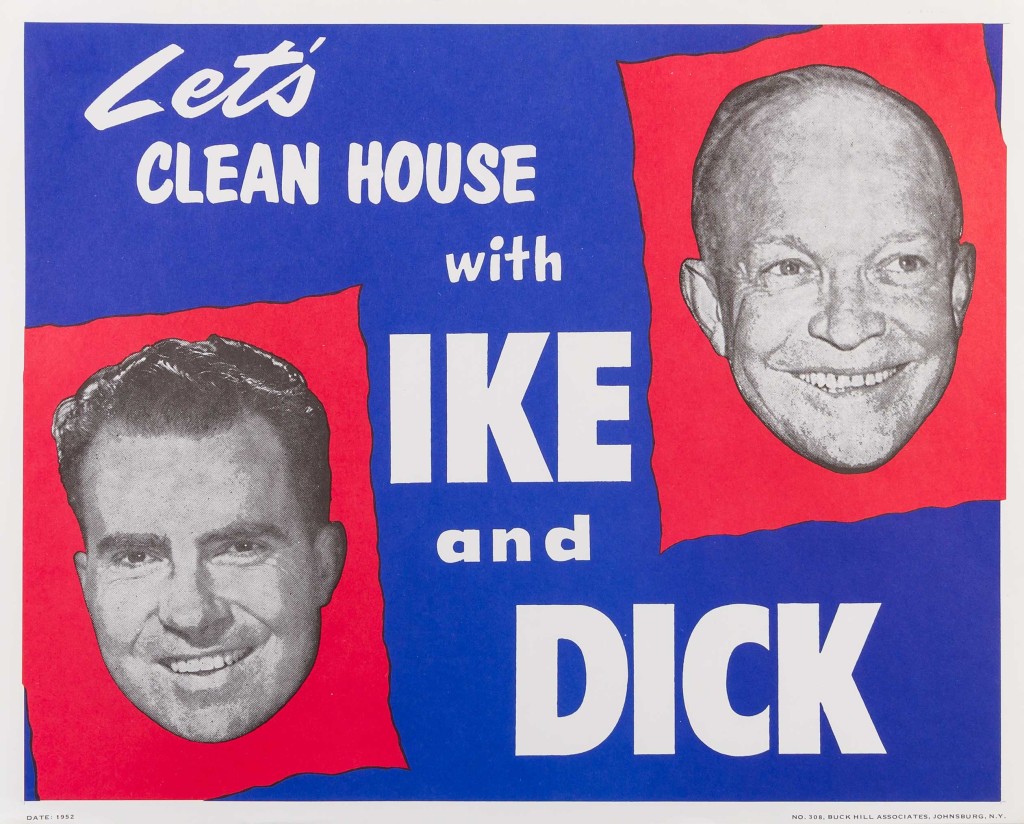
Another unique Eisenhower poster using the red, white and blue without the stars and stripes.
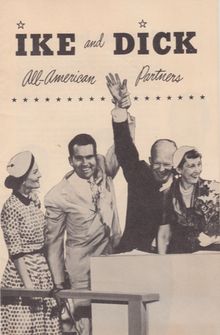
For the first-time the spouses of a presidential and vice-presidential candidate appeared on a poster and with good reason. The 1952 Eisenhower-Nixon campaign wisely targeted the women’s vote by casting economic and security issues through their perspective and used Mamie and Pat as their poster girls. The All-American Partners motto plays not only on the question of which partners – the marital or the political ones, and also gently addressed the era’s McCarthyism paranoia of subversive “anti-Americans” in the government. Finally, the plain brown-and-beige color is a radical departure from previous campaign posters. There’s not one bit of red, white or blue.
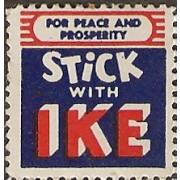
This 1956 postage seal made amusing reference to both Eisenhower’s re-election campaign and the adherence of the seal. Yet another interesting Eisenhower configuration of the red, white and blue.
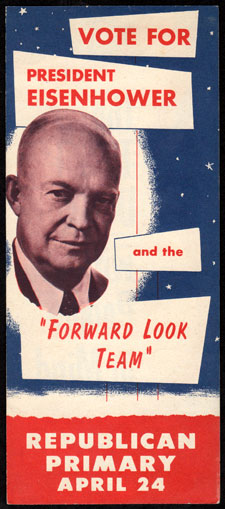
This Eisenhower pamphlet made unique space age use of the red-white-and-blue, turning the stars into the sort of things that spaceships would be passing, with one vaguely obligatory “stripe.”
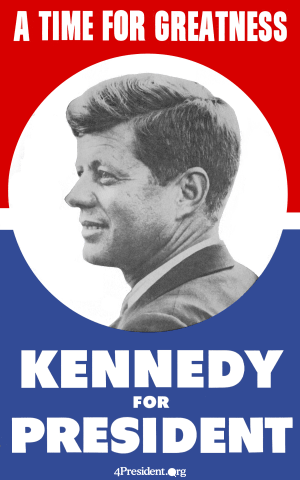
JFK used a classic Sixties pop art pattern, seeking to pin him to the decade to come.

Again using the Pop Art pattern, and again tying Kennedy to the decade that would so closely come to be associated with him.
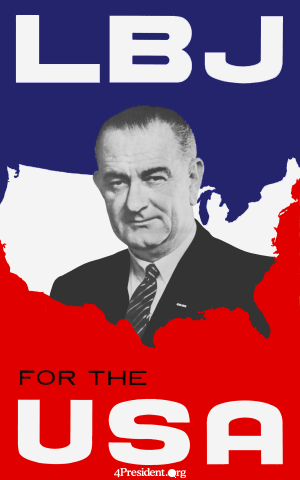
LBJ’s emphasis on domestic programs is made loud and clear in this slight variation of the Kennedy posters, and also echoes a popular Chevrolet car TV ad of the era.
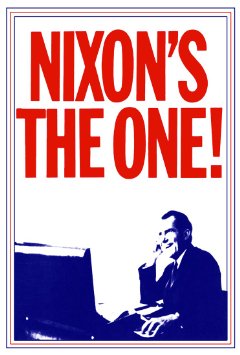
Abstract in its configuration, using an all-white background for the red font and blue illustration, this 1968 Nixon poster almost seems to predict the future – as if the candidate is using a mouse and looking at a PC screen.
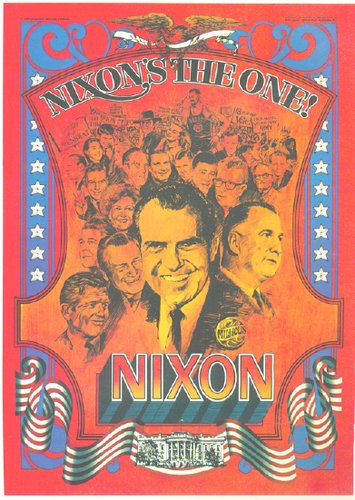
No campaign poster seemed to use more red than this psychedelic 1972 Nixon reelection poster, with the President as the center point of both left-wing and right-wing Republicans of his party, as well as his wife, daughter and son-in-law.
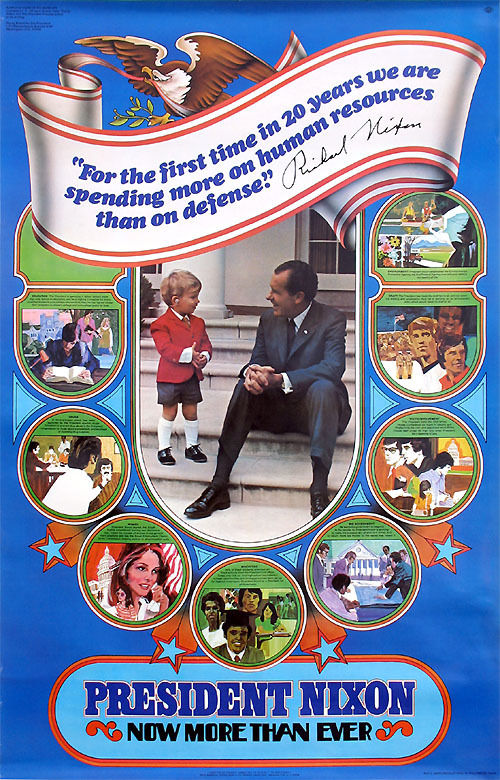
A mod Nixon for ’72, this Love-American-Style poster gave focus to women, minorities and youth in a way like no other – yet evoked the old Grant poster using multiple imagery. It’s almost like an old IG account.

Almost more JFK-like in its red-white-and-blue configuration, this Ford poster was right in Bicentennial style, using the popular First Lady Betty Ford with her husband on the day he took over upon Nixon’s resignation – without the need of a word to suggest the passing scandal.

In his effort to turn a new leaf on politics status quo, Jimmy Carter branded his campaign with the fresh color of green. No red or blue here kids.
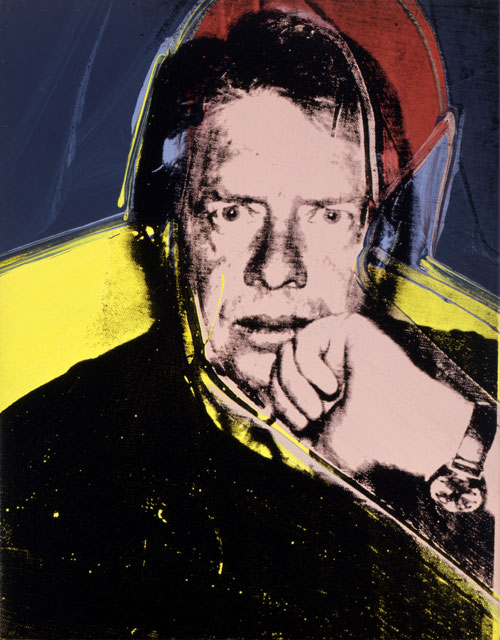
Hoping to gain popular traction among young voters, the National Democratic Committee commissioned Andy Warhol to do a Carter presidential campaign poster in limited edition.
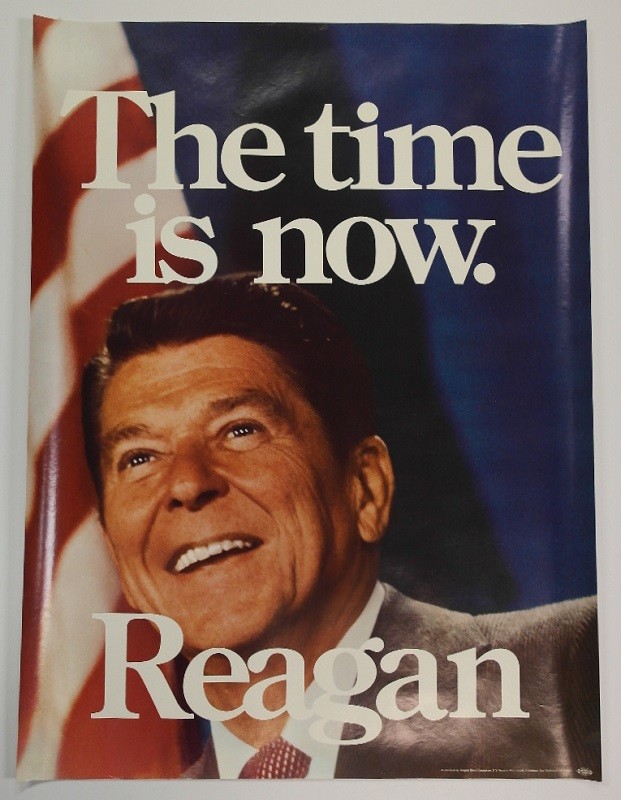
The words are white, the background is blue, and Old Glory makes her stripes known, but it is the personal popularity of Reagan, as he looks upwards and ahead to the future that is the center point of this 1980 poster.
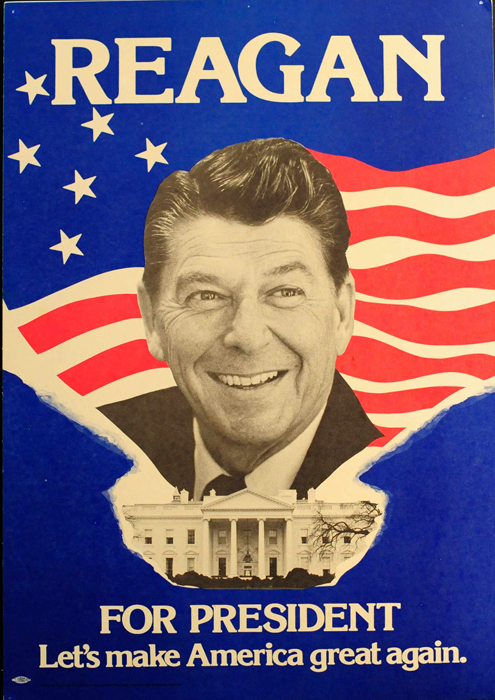
It was perhaps no accident that this Reagan poster evoked a style similar to those of Eisenhower in the 50s, with the promise to “Make America Great Again,” which has been taken again this year.
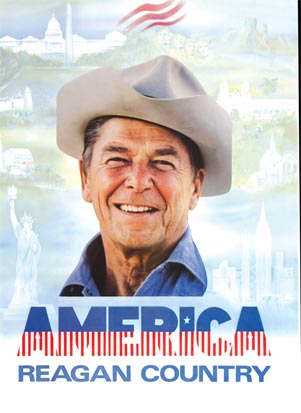
Intended to appeal to more maverick westerners and other non-traditional Republicans, all of America is nevertheless included in this classic “Reagan Country” poster, with pale white silhouettes of popular national scenes.
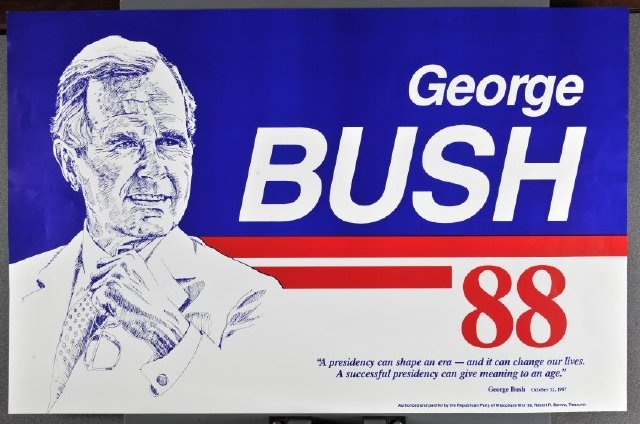
A restrained and somewhat traditional 1988 poster for Bush.

An appealing mix of the stars and stripes and charcoal drawing of the smiling Bush, called for voters to re-elect him in 1992.

Evoking the Reagan poster of simply using an enlarged photo of the candidate (and his running mate), this Clinton poster exhorted voters with the campaign byword of “hope.”

This sticker, the sort easily displayed in truck or car windshields, raised eyebrows in the early 1990s by the seeming contradiction of the racial symbolism of the Confederate flag being used to promote the candidacy of the liberal Bill Clinton and his running mate Al Gore, both of whom were also Southerners.
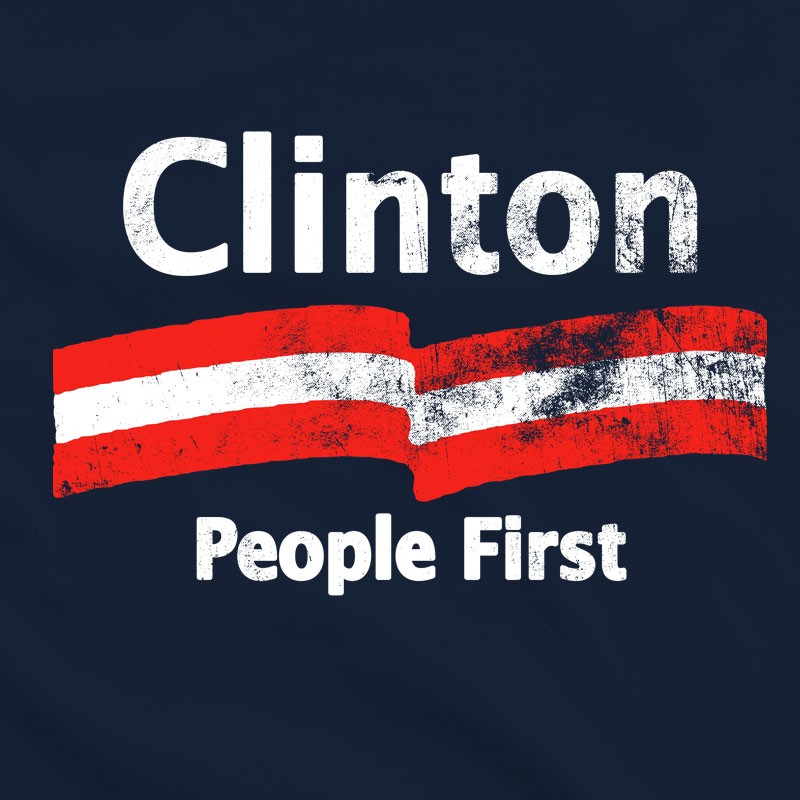
The Clinton call to put “People First” with a bit of antiquing on the old stars, suggests a traditional notion that’s time had come again.

The first and startling use of black on a presidential campaign poster, this George W. Bush poster makes use of the red-white-and-blue in its original form.

The branding of “W” in black and white struck a menacing note in 2004 without a touch of the blue or red.

The famous Obama poster that ended up costing the creator a lawsuit for copyright violation, yet managed to use the red-white-and-blue more uniquely than ever before and further, set off an entirely new trend in poster art.
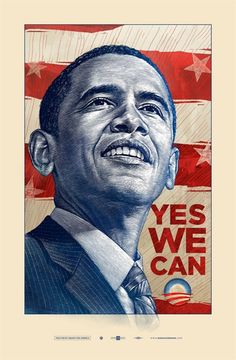
Taking off on the drawing version of the famous Obama poster above, this one cast the nation’s first African-American president in a shade of blue – the color of the Democratic Party.

Appearing in the latter part of the 2008 campaign, this poster in shades of blue artfully used the earlier posters – with its Obama logo and thereby, the touch of red.
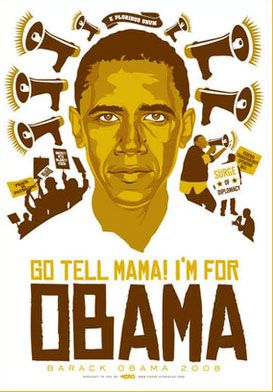
A little bit of irreverent hip-hop and the browns and gold with no need for blue or red, make this poster more art of an era than political propaganda.
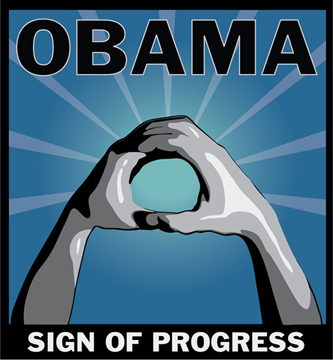
Perhaps one of the more beautiful, if vaguely cultish, of presidential campaign posters, the black and blue message never mentions a campaign or politics.
By the second decade of the 21st century, the need for official presidential campaign posters had vanished. Memes, gifs, and the like have made every citizen a presidential poster art creator. Practically every day of the 2016 presidential campaign year, one could find a new image used in support of, or opposition to the leading presidential candidates. Here are just two:
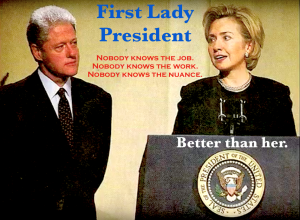
A reminder of the first unofficial federal position once held by the 2016 Democratic presidential frontrunner.

The expressed views and stance of the 2016 Republican presidential candidate frontrunner suggests to many a menacing future.
Categories: Politics, Presidential Campaigns and Elections, Presidents
Tags: Barack Obama, Donald Trump, Dwight D. Eisenhower, Franklin D. Roosevelt, Hillary Clinton, Richard Nixon, Ronald Reagan, Ulysses S. Grant
 Jane & Jill, Potential First Ladies: Lots in Common Between the Wives of Joe Biden & Bernie Sanders
Jane & Jill, Potential First Ladies: Lots in Common Between the Wives of Joe Biden & Bernie Sanders  The President as King: A Political Cartoon History
The President as King: A Political Cartoon History  All The Presidents’ Birthdays: Dance Balls to Movie Star Fundraisers in 90 Rare Photos
All The Presidents’ Birthdays: Dance Balls to Movie Star Fundraisers in 90 Rare Photos  Jefferson’s Warning About the Current Man Occupying the Presidency
Jefferson’s Warning About the Current Man Occupying the Presidency  A Dozen First Lady Fourths: Presidential Wives’ Independence Days Radically Diverse
A Dozen First Lady Fourths: Presidential Wives’ Independence Days Radically Diverse  First Ladies On The Steps & In the Car Together: A Century-Old Tradition
First Ladies On The Steps & In the Car Together: A Century-Old Tradition
Leave a Reply